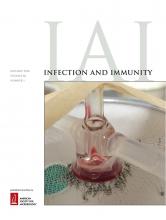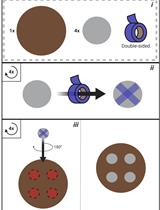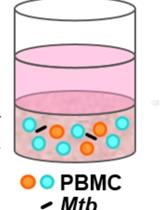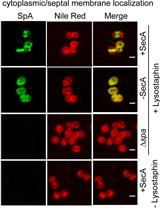- EN - English
- CN - 中文
High-throughput Microscopic Analysis of Salmonella Invasion of Host Cells
高通量显微分析沙门氏菌入侵寄主细胞
发布: 2018年09月20日第8卷第18期 DOI: 10.21769/BioProtoc.3017 浏览次数: 6553
评审: Emily CopeVishal NehruAnonymous reviewer(s)
Abstract
Salmonella is a Gram-negative bacterium causing a gastro-enteric disease called salmonellosis. During the first phase of infection, Salmonella uses its flagella to swim near the surface of the epithelial cells and to target specific site of infection. In order to study the selection criteria that determine which host cells are targeted by the pathogen, and to analyze the relation between infecting Salmonella (i.e., cooperation or competition), we have established a high-throughput microscopic assay of HeLa cells sequentially infected with fluorescent bacteria. Using an automated pipeline of image analysis, we quantitatively characterized a multitude of parameters of infected and non-infected cells. Based on this, we established a predictive model that allowed us to identify those parameters involved in host cell vulnerability towards infection. We revealed that host cell vulnerability has two origins: a pathogen-induced cellular vulnerability emerging from Salmonella uptake and persisting at later stages of the infection process; and a host cell-inherent vulnerability linked with cell inherent attributes, such as local cell crowding, and cholesterol content. Our method forecasts the probability of Salmonella infection within monolayers of epithelial cells based on morphological or molecular host cell parameters. Here, we provide a detailed description of the workflow including the computer-based analysis pipeline. Our method has the potential to be applied to study other combinations of host-pathogen interactions.
Keywords: Salmonella enterica serovar Typhimurium (鼠伤寒沙门氏菌)Background
Salmonella enterica serovar Typhimurium infects its host via ingestion of contaminated food or water, causing salmonellosis. Once the bacterium reaches the distal ileum of the gut, they can invade a broad range of host cells, including the intestinal epithelial cells (Watson and Holden, 2010). During the first phase of host cell invasion, Salmonella chooses its targets, using its flagellum to swim and scan the surface of the epithelium (Misselwitz et al., 2012). After several stops on the surface of the cells, the bacterium eventually chooses a site where it docks (Misselwitz et al., 2011; Vonaesch et al., 2013) and triggers its uptake via the Type 3 Secretion System (T3SS) (Haraga et al., 2008; LaRock et al., 2015). The injection of bacterial effectors directly into the cytosol of the targeted cells leads to a strong remodeling of the actin cytoskeleton and the formation of membrane ruffles that engulf the pathogen (Haraga et al., 2008; LaRock et al., 2015). Within the infected cells, Salmonella remains either within a mature endomembrane compartment, the Salmonella-containing vacuole (SCV); or it reaches the cytosol by SCV membrane rupture to replicate at distinct paces within the different intracellular niches (Knodler, 2015; Fredlund et al., 2018).
Eukaryotic cell monocultures display an intrinsic cellular heterogeneity. Indeed, after seeding, cells have different characteristics with regards to their morphology and the local microenvironment, which correlates with differences of the transcriptome, proteome, and lipidome (Snijder et al., 2009; Frechin et al., 2015; Liberali et al., 2015). The selection criteria that determine which host cells are targeted by Salmonella for invasion are poorly understood. Previously, Misselwitz and colleagues proposed that Salmonella preferentially targets the topological obstacles it encountered while swimming near the cell monolayer, such as ruffles or mitotic cells (Misselwitz et al., 2012; Lorkowski et al., 2014). In contrast, Santos and colleagues suggested that cholesterol accumulation during cell metaphase is responsible for mitotic cell targeting (Santos et al., 2013). In a recent study, we investigated at the single-cell level the criteria exploited by Salmonella to select the cell to infect in a naturally heterogeneous monolayer of cells (Voznica et al., 2018).
In order to link the features of each cell with its probability to be infected, we have established a protocol of double infection of HeLa cells with fluorescent bacteria. We imaged the cells with high-throughput microscopy combined with automatic image analysis to obtain the individual features of hundreds of thousands of cells. We observed the distribution of those features in infected and non-infected cells and used a mathematical model to resolve the importance of different cellular parameters in deciphering Salmonella targeting.
This protocol provides a new tool to analyze pathogen targeting of cell features in a non-invasive manner and at the single-cell level. This opens a new path to decipher the cellular and bacterial factors involved in host cell vulnerability to infection.
Materials and Reagents
- Cell culture
- Falcon® 15 ml Polystyrene Centrifuge Tubes, Conical Bottom, with Dome Seal Screw Cap, Sterile (Corning, catalog number: 352095 )
- Counting chamber (KOVA® Glasstic Slide 10 with Grids) (Kova International, catalog number: 87144 )
- 96-well cell culture microplate with clear flat bottom (Greiner Bio One International, catalog number: 655090 )
- 75 cm2 tissue culture flasks with tilting neck and filter caps (TPP Techno Plastic Products, catalog number: 009076 )
- Human epithelial HeLa cells (ATCC, catalog number: CCL-2 )
- Dulbecco’s Modified Eagle’s Medium (DMEM) 1x, High Glucose, GlutaMaxTM (Thermo Fisher Scientific, catalog number: 10566016 ) supplemented with 10% (v/v) heat-inactivated Fetal Bovine Serum (Sigma-Aldrich, catalog number: F7524 )
- DPBS 1x (Thermo Fisher Scientific, catalog number: 14190144 )
- 0.05% Trypsin-EDTA 1x (Thermo Fisher Scientific, catalog number: 25300054 )
- Heat-inactivated Fetal Bovine Serum (Sigma-Aldrich, catalog number: F7524 ) (see Recipes for heat-inactivation)
- Bacteria culture
- Inoculating loops (SARSTEDT, catalog number: 86.1562.010 )
- Falcon® 14 ml round bottom tube with snap cap (Corning, catalog number: 352006 )
- Round Petri plate (Corning, GosselinTM, catalog number: BP93B-102 )
- Bacterial glycerol stock, stored at -80 °C (lab collection)
- SL1344 pM965, expressing GFP under the rpsM promoter. The strain was obtained after transformation of SL1344 with the pM965 plasmid described by Stecher and colleagues (Stecher et al., 2004). See Recipes for transformation.
- SL1344 pGG2, expressing dsRed under the rpsM promoter. The strain was obtained after transformation of SL1344 with the pGG2 plasmid described by Lelouard and colleagues (Lelouard et al., 2010). See Recipes for transformation.
- Electroporation Cuvettes (Bio-Rad Laboratories, catalog number: 1652086 )
- Ampicillin (Sigma-Aldrich, catalog number: A9393 ) (Keep the stock solution of 50 mg/ml at -20 °C)
- Tryptone (BD, catalog number: 211705 )
- Yeast Extract (BD, catalog number: 212750 )
- NaCl (Sigma-Aldrich, catalog number: 746398 )
- LB agar plate containing Ampicillin at 100 μg/ml (homemade, see Recipes)
- Lysogeny broth (LB) medium supplemented with 0.3 M NaCl (homemade, see Recipes)
- Infection
- 1.5 ml Eppendorf safe-lock tubes (Eppendorf, catalog number: 0030120086 )
- Semi-micro disposable cuvettes (BRAND, catalog number: 759105 )
- Parafilm® M sealing tape (Sigma-Aldrich, Parafilm, catalog number: P7543 )
- Pipetting reservoir, 25 ml (Thermo Fisher Scientific, catalog number: 10717964 )
- Filter tips, 200 µl (Sorenson Bioscience, catalog number: 035230 )
- Gentamicin solution (Sigma-Aldrich, catalog number: G1397 ) (Keep the stock solution of 50 mg/ml at -20 °C)
- NaCl (Sigma-Aldrich, catalog number: 746398 )
- KCl (Thermo Fisher Scientific, catalog number: 13305 )
- CaCl2 (Sigma-Aldrich, catalog number: 449709 )
- MgCl2 (Sigma-Aldrich, catalog number: M8266 )
- Glucose (Sigma-Aldrich, catalog number: G8270 )
- HEPES (Sigma-Aldrich, catalog number: H3375 )
- Heat-inactivated Fetal Bovine Serum (Sigma-Aldrich, catalog number: F7524 ) (see Recipes for heat-inactivation)
- 20x EM medium (homemade, see Recipes)
- 1x EM medium (see Recipes)
- Fixation
- Staining
Equipment
- Single-channel pipettes (Eppendorf, model: Research® plus )
- Multichannel Pipette, 30 to 300 μl (Thermo Fisher Scientific, catalog number: 4661030N )
- Pipet Filler (Thermo Fisher Scientific, catalog number: 9501 )
- Inverted Microscope (Motic, model: AE2000 )
- Laminar hood (Thermo Fisher Scientific, model: 1300 Series Class II Type A2 )
- Incubator set at 37 °C, 5% CO2 (Thermo Fisher Scientific, catalog number: NC0689918 )
- Centrifuge 5810/5810 R (Eppendorf, model: 5810/ 5810 R )
- Incubator with orbital shaker (INFORS, Multitron no series 112569-3)
- Water Bath (JULABO, model: TW12, catalog number: 9550112 )
- Thermomixer compact (Eppendorf, model: ThermoMixer® C )
- Photometer (Eppendorf, AG 22331)
- Centrifuge 5424/ 5424 R (Eppendorf, model: 5424/5424 R )
- Fume hood (SORBONNE ASPRIL/1000)
- Inverted widefield microscope equipped with a 20x/0.5NA air objective, an automatic programmable XY-stage, and a focusing system (Nikon), a CoolSnap2 camera (Roeper Scientific), a mercury lamp and the following filter cubes: DAPI (Excitation filter: 387/11, Emission filter: 447/60), FITC (Excitation filter: 482/35, Emission filter: 536/40), TRITC (Excitation filter: 543/22, Emission filter: 593/40) Cy5 (Excitation filter: 628/40, Emission filter: 692/40)
- 250 ml Erlenmeyer flask
- Electroporation Systems (Bio-Rad Laboratories, model: Gene Pulser XcellTM )
- Double boiler: 2 L beaker filled with 600 ml water
- Microwave
Software
- NIS-Elements Microscope Imaging Software (Nikon)
- Icy (Copyright 2011 Institut Pasteur, Icy is free software under the terms of the GNU General Public License, http://icy.bioimageanalysis.org)
- R (R is free software under the terms of the GNU General Public License, https://www.r-project.org/). The code available in the data analysis part has been written with R, version 3.4.2
- GraphPad Prism version 7.00 for Windows, GraphPad Software (La Jolla California USA, www.graphpad.com)
Procedure
文章信息
版权信息
© 2018 The Authors; exclusive licensee Bio-protocol LLC.
如何引用
Voznica, J., Enninga, J. and Stévenin, V. (2018). High-throughput Microscopic Analysis of Salmonella Invasion of Host Cells. Bio-protocol 8(18): e3017. DOI: 10.21769/BioProtoc.3017.
分类
微生物学 > 微生物-宿主相互作用 > 体外实验模型
微生物学 > 微生物细胞生物学 > 细胞成像
您对这篇实验方法有问题吗?
在此处发布您的问题,我们将邀请本文作者来回答。同时,我们会将您的问题发布到Bio-protocol Exchange,以便寻求社区成员的帮助。
提问指南
+ 问题描述
写下详细的问题描述,包括所有有助于他人回答您问题的信息(例如实验过程、条件和相关图像等)。
Share
Bluesky
X
Copy link














